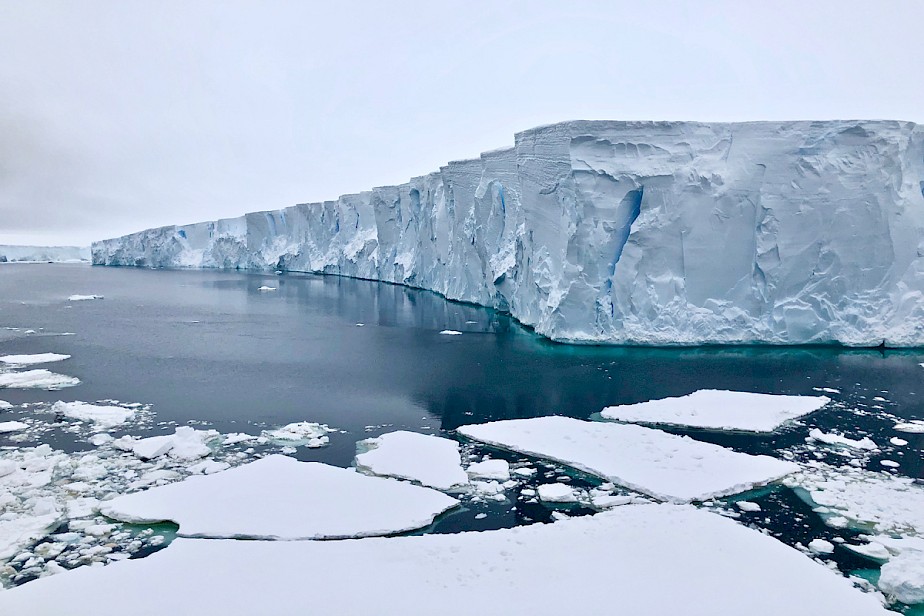35 million year old data could unlock future of Antarctica

Scientists have unravelled the secrets of a period 35 million years ago when Earth cooled rapidly, leaving Antarctica shrouded in ice.
The findings could help to predict the unstable future of the West Antarctic ice sheet, researchers from the Alfred Wegener Institute say.
For climate researchers, the West Antarctic has been a focus for years - and the new finding helps to understand how ice sheets formed there in the first place.
At this point, the West Antarctic Ice Sheet which lies on top of the continent stretches to the Amundsen Sea.
Near the coast, the ice is still in direct contact with the soil; farther toward the open sea, it floats.
Because climate change progressively warms the seawater, it is eroding the ice shelf from below.
The grounding line - the last point at which the ice still rests on the ground - moves farther and farther inland. Due to meltwater and calving icebergs, the Thwaites Glacier, which flows into the Amundsen Sea, now loses twice as much ice as 30 years ago.
Thwaites is often described as ‘the doomsday glacier’, due to the catastrophic effects if it collapsed - with a sea level rise of up to nine feet.
Even now, ice draining from Thwaites into the Amundsen Sea accounts for about four percent of global sea-level rise - as it dumps 50 billion tonnes of ice into the ocean each year.
Lead author Gabriele Uenzelmann-Neben from the Alfred Wegener Institute, Helmholtz Centre for Polar and Marine Research (AWI) said: “The stability of the West Antarctic Ice Sheet is critical to the future development of the global sea level.
“Accordingly, researchers around the world are working to predict the future behaviour of the ice in a warmer world using numerical simulation.
The more we know about the history of the West Antarctic Ice Sheet, the more accurate we can make these models. Its more recent history is well-documented, but we still know very little about its earlier years - particularly the formation phase. Our study delivers an important piece of the puzzle.”
Roughly 35 million years ago, Earth cooled rapidly.
Around the same time, the Drake Passage formed between South America and the Antarctic, paving the way for the Antarctic Circumpolar Current - meaning Antarctica was soon completely covered in ice.
In the course of two research cruises onboard the Polarstern, the research investigated sediments in the vicinity of Pine Island Trough, a channel-like furrow in the seafloor of the shallow part of the Amundsen Sea.
The measurement data revealed a large sediment body, a sediment drift, on the eastern flank of Pine Island Trough, one with no counterpart on its western side.
“Because of the Coriolis effect produced by Earth’s rotation, this asymmetrical deposition of a sediment drift on the trough’s eastern side but not the western one can only have been produced by a deep-water current that flowed toward the coast from north to south,” says Uenzelmann-Neben.
“In order for that to occur, the ocean circulation at the time of the deposition had to be similar to today’s conditions, that is, the prevailing westerlies and the Antarctic Circumpolar Current had to have been located far to the south. And similar to today, the deepwater upwelled through the trough must have been comparatively warm.”
Additional study of pollen from sediment cores gathered near the trough indicate that the base of the sediment drift was formed roughly 34 to 36 million years ago.
“Our study offers compelling evidence that at the time of the great glaciation, warmer deep water upwelled near the Amundsen Sea shelf and delayed the West Antarctic Ice Sheet’s expansion to the sea,” the AWI Geophysicist explains.
“This important and unexpected finding emphasises the tremendous importance that ocean currents had even during the formation phase of the West Antarctic Ice Sheet and continue to have today. Armed with this additional knowledge concerning the ice sheet’s earliest phase, forecasts on its future stability and ice retreat can now be improved.”
In December, Paul Cutler, programme director for Antarctic glaciology at America’s National Science Foundation said, “Thwaites is a keystone for the other glaciers around it in West Antarctica … If you remove it, other ice will potentially start draining into the ocean too.”
Cutler says that the Thwaites glacier is losing ice faster and faster, and that the process seems to be accelerating.
Cutler said, “The big question is how quickly it becomes unstable. It seems to be teetering at the edge.”
Rob Larter, UK principal investigator for the Thwaites Glacier Project at the British Antarctic Survey told the FT, “It is the most vulnerable place in Antarctica.”
The South Pole, the most remote place on the planet, has warmed three times faster than other areas over the past three decades, researchers say.
You can return to the main Market News page, or press the Back button on your browser.

